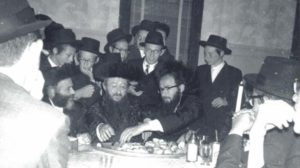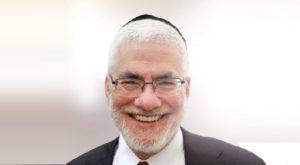So What Is the Solution?

In the face of personal challenge, how should a person endeavor to react?
Magazine articles, as opposed to books or long essays, tend to focus on narrow issues. And so in my previous article, “Mashiach Is Not the Solution,” I focused on particular points that are actually part of a wider topic. Some of the feedback indicated that a larger and more structured outline would be appreciated. Here is my attempt to do that, albeit within the limited framework of an article.
First, let us reframe our question about “solutions.” Hashem is the source of solutions; our job is to perform the tasks we were charged with to the best of our abilities. The pasuk (Mishlei 16:1) says, “l’adam maarchei lev — man has the ability to set his heart right; but u’mei’Hashem maaneh lashon — it is Hashem Who puts the words in our mouths — i.e., the finished product is Hashem’s domain.”
The question we need to ask ourselves, therefore, is not “What is the solution?” but rather, “What are my obligations, and what is the best that I can do in this situation?”
More precisely, our question is, “When a person faces difficulty, adversity, challenge, suffering, tragedy, etc., what action is incumbent upon him?”
I think that in order to answer this, it is helpful to divide the challenges and difficulties into three major categories: personal, communal, and national. (We see the importance of correctly breaking down the issues in the way Chazal compartmentalized the Shemoneh Esreh prayer: first we daven for help with personal needs — i.e., dei’ah, refuah, parnassah, teshuvah, etc. We also daven for Yerushalayim, Torah leadership, monarchy, and we daven for an end to the catastrophic state of the Jewish People as a people — i.e., Re’eh na v’anyeinu… Ga’al Yisrael.)
1. Personal Challenges: Every person endures his share of difficulty, adversity, challenge, and suffering. The Ramchal (Derech Hashem 2:3) lists numerous causes for these difficulties. This first and foremost is “mazel,” which does not mean blind fate or fortune, as commonly misunderstood, but rather the individual mission for which Hashem sent each person into This World.
Thus, one person’s mission may be to study despite intellectual handicaps, another’s mission might be to maintain his integrity and faith despite financial shortfalls, and a third person’s mission may be to overcome his naturally hostile personality and get along with others.
The Ramchal offers several more possible causes for difficulties: Hashem sometimes uses difficulties as a message that there is need for improvement, and sometimes as a medium to cleanse a person of sin.
The Ramchal elaborates that suffering may come from a combination of factors, such that no person can ever be sure of the origin of his particular brand of suffering. When we had prophecy, a navi could tell us precisely why we were enduring a certain trial, but it has been approximately 2,500 years since we had prophecy, and the ruach hakodesh of today’s chachamim is far more subtle and limited than nevuah. Today, we rarely — if ever — can answer why one is suffering, and certainly not the full answer.
So then back to our question: In the face of personal challenge, how should a person endeavor to react?
The Gemara in Niddah (70b) asks what a person should do when in need of wisdom, money, or children. It answers that he should make the requisite mundane efforts to attain his needs, and concurrently, he should pray for that need to be fulfilled. It then concludes that the point of this Gemara is to teach us that neither effort alone nor prayer alone is sufficient, but rather both together are needed.
We are never allowed to forget that Hashem is the ultimate Provider, but on the other hand, we may never rely on the miraculous. We need to expend our fullest effort (within the range of what is considered reasonable effort), while simultaneously davening in a way that demonstrates our understanding that the success of our endeavors depends solely on HaKadosh Baruch Hu.
Still, there are times when we sense that we are experiencing something extraordinary, something far more than a “normal” personal challenge. The extreme nature of the challenge prompts us make some sort of fundamental change. Indeed, Chazal tell us that if “suffering befalls a person, he should inspect his actions” (Berachos 5a). If a person, after examining his actions and lifestyle, finds something requiring change, it is most appropriate that he work to effect that change. A divinely inspired tzaddik or chacham (with “ruach hakodesh”) may also at times try to help us put a finger on what it is that we are being prompted to do.
Above all, alongside the effort, tefillah, and teshuvah, a person must always bear in mind the concept of Hashgachah, no matter the cause of his difficulties. No travails are a product of blind fate. Rather, all that befalls a person is deliberate, designed precisely by Hashem’s Hashgachah. Sometimes we are fortunate enough to perceive an element of that precision, and other times we fathom not a hint of it.
2. Communal Challenges: At times a specific community faces a calamity. The Torah directs us toward the correct response in this case as well.
The Rambam in the first perek of Hilchos Taanios explains that it is a Torah obligation to cry out to Hashem and to blow chatzotzros when calamities befall a community. He explains that these blasts of the chatzotzros arouse us toward teshuvah. The chachamim added other measures: fasting, particular prayers, and communal, coordinated introspection (i.e., the elders of the city meet and discuss what needs to be amended).
Interestingly, nowhere are the elders instructed to look for signs of middah k’neged middah (matching the trial to some specific bad behavior or failing) or hints as to why the calamity happened. They are simply instructed to conduct serious communal soul-searching, in keeping with their responsibility for the community’s moral rectitude.
The Rambam emphasizes the need to recognize that unusually bad events that befall a tzibbur are a Divine call for improvement, and he gives us guidelines (Taanios 1:3, based on the Gemara) to recognize which events bear the characteristics of an unusual and community-threatening event. (It should be noted that the Rambam’s qualifiers are hard to apply to contemporary reality and it is up to the elders of each generation to make the necessary judgment calls.)
Although the Torah demands that we recognize the Hashgachah involved in these communal troubles, and therefore address the spiritual issues, we are similarly told not to spare any practical and natural effort in dealing with the tzarah. For example, the Gemara in Eiruvin (45a) deals with the obligation to muster force and repel enemies attacking us on Shabbos, even if it is not apparent that the situation is life-threatening. The need to use natural means was true all through our history; we went out to fight, while concurrently davening (see, for example, Ha’amek Davar Devarim 33:18, based on Chazal). Similarly, the Gemara (Bava Kamma 60b) also offers advice on what’s considered appropriate hishtadlus when facing plagues or famine.
And finally, we have the ultimate model for combining ruchniyus- and gashmiyus-oriented approaches to dealing with communal danger: Yaakov Avinu. When his extended family (a community of sorts) faced existential danger, the pesukim and Chazal tell us that he worked on three parallel fronts: prayer, tribute, and battle. The Ramban (beginning of Vayishlach) adds that this is the formula for all generations to come. When we are faced with communal challenges, Hashem demands all of the above from us.
3. National Challenges: National challenges are in a category of their own — and not just because of the scope of their influence. In fact, while communal challenges sometimes affect the entire Jewish Nation (for example, a famine or plague may strike national Jewish communities across the globe), we do not classify those as “national” issues. What makes a challenge “national” rather than “communal” depends not on mere demographics, but on its essential nature. Specifically, a national challenge involves the issues surrounding nationhood itself and relating to galus versus Geulah.
Since we have gone into galus, our relationship with Hashem has become a shadow of the former bond that we had. We have suffered losses to all our expressions of nationhood (monarchy, unity, Torah, etc. — as delineated in my previous article about Mashiach). And we have not ceased suffering the constant turmoil of being a stateless group of nomads, battered by every little wind. This reality is patently true, although it takes on different nuances, regardless of one’s outlook on the State of Israel.
However, the issue that seems to confuse people is the interweaving of the “spiritual deterioration” with the physical suffering that Klal Yisrael has endured and does endure. Many others have voiced confusion about the interplay between individual and national suffering. Which one is Mashiach all about?
In order to best put into perspective the combination of the spiritual loss together with the physical pain and suffering, let us use a model that Chazal themselves have given us: “Woe unto a child that has been sent away from his parents’ table” (Berachos 3a).
Imagine a child who’s misbehaved so badly that he has been cast out of his home. He is now on the street, cold and shivering, hungry and thirsty, and assaulted by beasts and thugs. As he suffers the woes and travails of a homeless child, he begins to dream of the home that he has lost.
At first, he wishes for the shelter and food that comes along with being home, just to be free from his woes. But slowly he begins to yearn for home itself: a place where a person is wanted and loved, a place where he belongs, a place that allows him to exist as himself.
A nation exists in a context. For almost all nations nowadays, that means a territorial context. For Klal Yisrael, the context of our existence as a nation is our covenant with Hashem; we are His people. This is not a statement about us; it is our essential definition.
Our national context revolves around a relationship. Eretz Yisrael is the place wherein He wishes that this relationship ideally takes place.
After a millennium of abusing this relationship, we were cast out of our home. Not only were we expelled from the physical Eretz Yisrael, but our existential context of being the “Am Hashem” was severely shaken.
Since we were cast out of our home, all the woes of a homeless child have constantly befallen us. We have no place where we can exist naturally. We are at best tolerated, and even that seems always to end with expulsion or persecution. We have built so much, and it has all gone up in flames: Spain, Portugal, France, Germany, Russia, Eastern Europe, North Africa, Iraq, Iran, and so on. And in all those places that we sojourned, we were caught in the crossfire between assimilation and annihilation.
When over the last century we stunningly, with Hashem’s glaring Hashgachah, returned to and built up Eretz Yisrael, we had the right to expect the nations to accept us as a “normal” nation, with the same right of existence as any other nation. Yet once again we are a “tolerated” nation at best. This, despite the fact that by all societal standards, we have built a magnificent state.
And so our continued existence can never be taken for granted. We cannot survive on “status quo.” We remain homeless until a true home comes into existence for us once again.
So where are we today? Assimilation has robbed us of the huge majority of Klal Yisrael. Our existence is precarious. We have no unified national leadership, and much of the time we devolve into bickering tribes. Our sense of connection to Hashem as a tzibbur is frail. And perhaps worst of all, when we are a troubled nation, we become a chillul Hashem. Rashi (Yechezkel 39:7) says, “Yisrael’s degradation is a chillul Hashem, for the nations jeer, ‘This is G-d’s nation, and He is powerless to stop their suffering.’ ”
These are the macro problems that face Klal Yisrael as a nation.
Just as a physical ailment caused by one underlying factor may breed many symptoms, so do galus and the destruction of our home cause much suffering; all of them are symptoms of the great void in our nationhood. The physical woes are the symptoms that prompt us to seek help, but only treatment of the underlying disease can bring permanent relief.
The galus is the national problem, the source of the illness; the solution (or “cure”) is the Mashiach and the Geulah. What initially motivates us to seek help is our national suffering (the symptoms), but help will only come when we treat the underlying issue and fulfill our mandate and the mitzvos. Among them is our mandate to properly seek our “home” — i.e., to believe in and eagerly anticipate the arrival of Melech haMashiach.
Chazal have set aside two special times for davening for the Geulah. The first is the bein hameitzarim period culminating in Tishah B’Av, when we reflect on how much devastation our homelessness has brought upon us. The second special time is the Yamim Tovim. Each Yom Tov’s special Mussaf Shemoneh Esreh reflects on what Yom Tov was like when we were home, and Hashem welcomed us with a Divine smile, so to speak, Yom Tov after Yom Tov.
So yes, like the banished child who roams the streets and dreams of home, the hunger, the cold, and the danger of galus force us to look for help. But help will only come when we manage to cure the true source of illness — when we yearn for the Father around Whose table we congregated.
(Originally featured in Mishpacha, Issue 820)
Oops! We could not locate your form.












